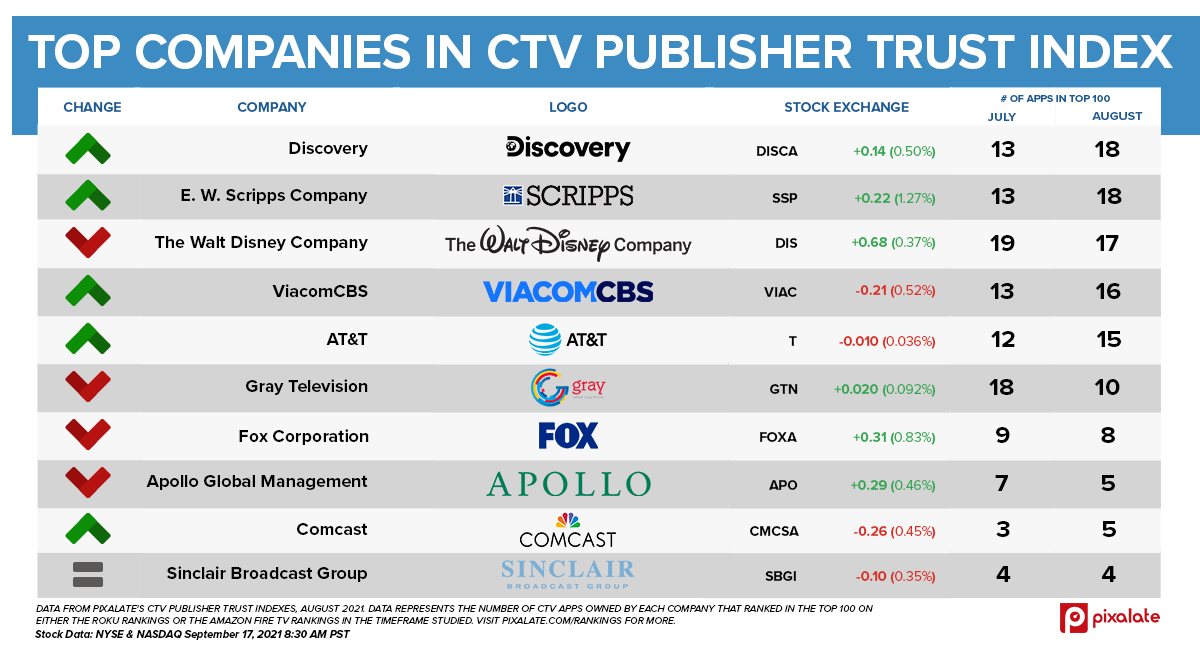

Discovery, Inc. (DISCA) and E. W. Scripps Company (SSP) were the leaders of publicly-traded companies which own the highest-quality apps for advertisers in August 2021, based on Pixalate’s analysis in our Publisher Trust Index.
Both Discovery and E. W. Scripps were represented by 18 apps ranked in the top 100 of the Publisher Trust Indexes for Roku and Amazon Fire TV. Compared to July's rankings, this is a significant increase, where Discovery (DISCA) and E. W. Scripps (SSP) had 13 apps ranked in the top 100s.
To reach the No. 1 position, E. W. Scripps (SSP) advanced remarkably from the second straight month. The company had 4 apps in the top 100s in June, 13 in July, and finally 18 in August to become a leader of Pixalate's ranking. E. W. Scripps (SSP) focuses mainly on regional TV news stations, which distinguish themselves with extraordinary quality of advertising environment. The company's portfolio includes WTVF NewsChannel 5 Nashville, WXYZ 7 Action News Detroit, and Court TV, among others.
For Discovery (DISCA), this is its second time at the top after leading the way in May 2021. The company owns apps covering various topics, from science to home and garden. Discovery's portfolio includes Science Channel, Discovery GO, and HGTV GO, among others.
Three other publicly-traded companies were closely behind Discovery and E. W. Scripps, including:
Since the beginning of Pixalate's ranking, the number of apps owned by publicly traded companies has been higher for Amazon Fire TV’s top 100 apps than Roku. August was no different. There were 80 apps from the Amazon Fire TV top 100 owned by companies listed on stock exchanges compared to 49 for Roku.
*Three apps are co-owned 50/50 by ViacomCBS and AT&T and were included in the count of both companies
Disclaimer
The content of this blog, and the Publisher Trust Indexes (collectively, the “Indexes”), reflect Pixalate’s opinions with respect to factors that Pixalate believes may be useful to the digital media industry. The Indexes examine programmatic advertising activity on mobile apps and Connected TV (CTV) apps (collectively, the “apps”). As cited in the Indexes and referenced in the Indexes’ key findings reproduced herein, the ratings and rankings in the Indexes are based on a number of metrics (e.g., “Brand Safety”) and Pixalate’s opinions regarding the relative performance of each app publisher with respect to the metrics. The data is derived from buy-side, predominantly open auction, programmatic advertising transactions, as measured by Pixalate. The Indexes examine global advertising activity across North America, EMEA, APAC, and LATAM, respectively, as well as programmatic advertising activity within discrete app categories. Any insights shared are grounded in Pixalate’s proprietary technology and analytics, which Pixalate is continuously evaluating and updating. Any references to outside sources in the Indexes and herein should not be construed as endorsements. Pixalate’s opinions are just that, opinions, which means that they are neither facts nor guarantees; and neither this press release nor the Indexes are intended to impugn the standing or reputation of any person, entity or app.
*By entering your email address and clicking Subscribe, you are agreeing to our Terms of Use and Privacy Policy.
These Stories on CTV
*By entering your email address and clicking Subscribe, you are agreeing to our Terms of Use and Privacy Policy.

Disclaimer: The content of this page reflects Pixalate’s opinions with respect to the factors that Pixalate believes can be useful to the digital media industry. Any proprietary data shared is grounded in Pixalate’s proprietary technology and analytics, which Pixalate is continuously evaluating and updating. Any references to outside sources should not be construed as endorsements. Pixalate’s opinions are just that - opinion, not facts or guarantees.
Per the MRC, “'Fraud' is not intended to represent fraud as defined in various laws, statutes and ordinances or as conventionally used in U.S. Court or other legal proceedings, but rather a custom definition strictly for advertising measurement purposes. Also per the MRC, “‘Invalid Traffic’ is defined generally as traffic that does not meet certain ad serving quality or completeness criteria, or otherwise does not represent legitimate ad traffic that should be included in measurement counts. Among the reasons why ad traffic may be deemed invalid is it is a result of non-human traffic (spiders, bots, etc.), or activity designed to produce fraudulent traffic.”

